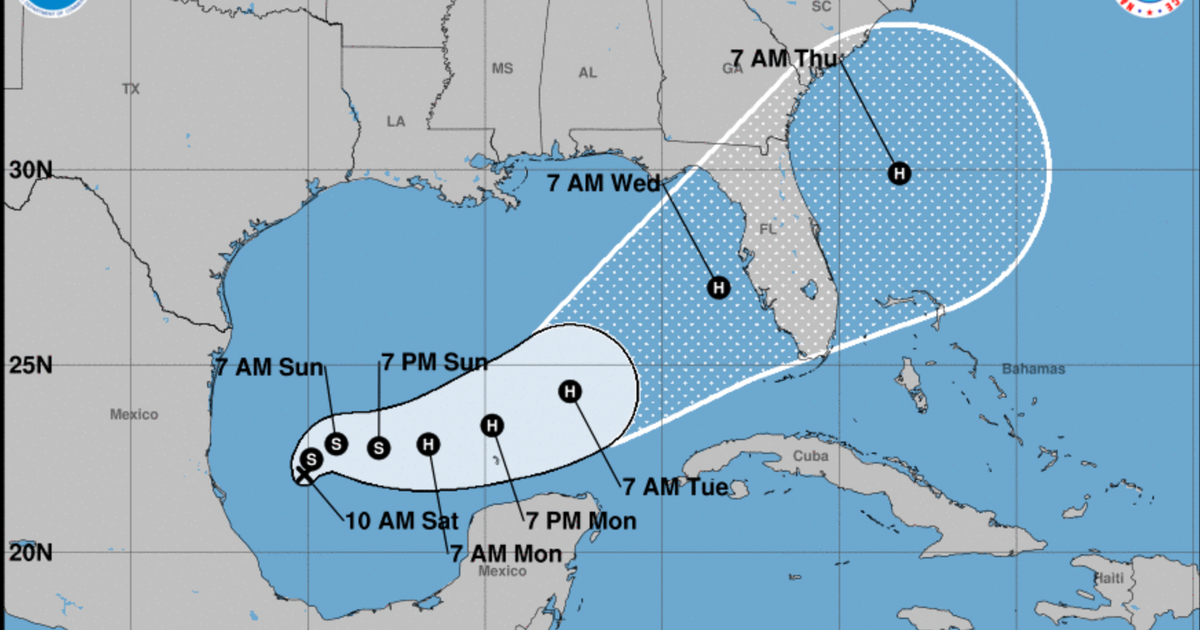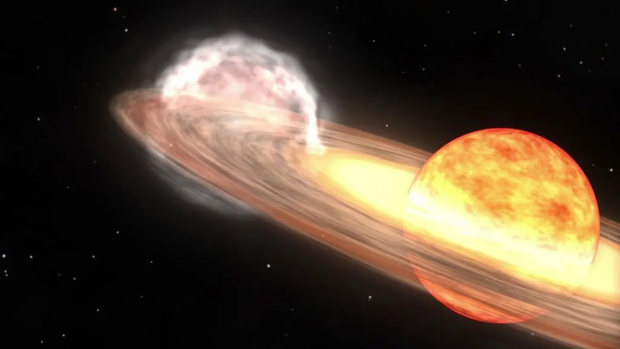CBS News
“Once-in-a-lifetime” cosmic explosion is likely this summer, NASA says. Here’s what to know.

A rare eruption of light from a dead star will likely be visible to people on Earth this summer in a fleeting but potentially stark celestial display that scientists are calling “a once-in-a-lifetime event.”
The technical term for the impending cosmic explosion is nova, which happens when a white dwarf lights up suddenly and often strikingly in the night sky. “White dwarf” is how astronomers describe a star at the end of its life cycle, after it has exhausted all of its nuclear fuel and only its core remains. As opposed to a supernova — another solar phenomenon visible from Earth, when a star effectively explodes — a nova instead refers to a dramatic ejection of material that a white dwarf has accumulated over time from a younger star in its close proximity.
“It’s a once-in-a-lifetime event that will create a lot of new astronomers out there, giving young people a cosmic event they can observe for themselves, ask their own questions, and collect their own data,” said Rebekah Hounsell, an assistant research scientist at NASA’s Goddard Space Flight Center who specializes in nova events, in a statement. “It’ll fuel the next generation of scientists.”
Between now and September, scientists expect that a nova in the Corona Borealis, or Northern Crown, of the Milky Way will send a flash so powerful into space that the naked eye can witness it, NASA announced recently. It will materialize in a dark spot in the constellation, where violent interactions between a white dwarf and a red giant are set to culminate in this massive blast.
A red giant is a dying star in the final phase of its life cycle, becoming increasingly turbulent as it expands and periodically expels material from its outer layers in intense episodes.
NASA/Goddard Space Flight Center
Known together as T Coronae Borealis, also named the “Blaze Star,” the white dwarf and red giant forecasted to create a nova this summer compose a binary star system in the Northern Crown, located around 3,000 light-years from Earth. The red giant in this pairing is constantly being stripped of hydrogen as it continues along its path toward total collapse, while the white dwarf nearby pulls that material into its own orbit, according to NASA. The hydrogen siphoned off of the red giant accumulates on the surface of the white dwarf over a number of decades, until the heat and pressure has built to such an extent that it prompts a full-blown thermonuclear explosion.
The blast, akin to a nuclear bomb in its appearance, rids the dead star of that excess material. The eruption will probably be be visible on Earth for about one week before it disappears again, but both the white dwarf and red giant in the Blaze Star system will still be intact whenever it fades. At that point, the process of hydrogen buildup between the two stars restarts, and it will continue until the accumulation of material on the white dwarf reaches its threshold the next time and abruptly explodes.
Different binary systems like T Coronae Borealis move through this cycle at different speeds. A nova typically erupts out of the Blaze Star about every 80 years or so.
“There are a few recurrent novae with very short cycles, but typically, we don’t often see a repeated outburst in a human lifetime, and rarely one so relatively close to our own system,” Hounsell said. “It’s incredibly exciting to have this front-row seat.”
When the nova in T Coronae Borealis eventually occurs, it will be the first one out of that pairing witnessed from Earth since 1946, according to NASA. The agency advised hopeful stargazers to look for the Northern Crown, which it describes as “a horseshoe-shaped curve of stars west of the Hercules constellation,” on clear nights. NASA also encouraged citizens to observe the phenomenon as best they can, even though its own scientists will study the nova at its peak and throughout its decline.
“But it’s equally critical to obtain data during the early rise to eruption,” said Hounsell, “so the data collected by those avid citizen scientists on the lookout now for the nova will contribute dramatically to our findings.”
CBS News
A look at the increased security at Trump’s Butler rally

Watch CBS News
Be the first to know
Get browser notifications for breaking news, live events, and exclusive reporting.
CBS News
$100 million in federal funds released for North Carolina to rebuild roads, bridges damaged by Helene

Washington, D.C. – The U.S. Department of Transportation released $100 million in emergency funds on Saturday for North Carolina to rebuild its roads and bridges damaged by Helene.
“We are providing this initial round of funding so there’s no delay getting roads repaired and reopened, and re-establishing critical routes,” said U.S. Transportation Secretary Pete Buttigieg in a statement. “The Biden-Harris administration will be with North Carolina every step of the way, and today’s emergency funding to help get transportation networks back up and running safely will be followed by additional federal resources.”
The storm caused rampant flooding that has devastated several towns and killed more than 225 people – with CBS News confirming at least 114 people killed in North Carolina. There was more than 8 inches of rain across the western North Carolina mountains, with some areas seeing more than a foot.
Hundreds of roads across Western North Carolina remain closed, leading to an increase in air traffic as teams scour the region for survivors by air. Air traffic over Western North Carolina has increased by 300% due to relief efforts since the storm cleared, the Federal Aviation Administration and the North Carolina Department of Transportation.
Mudslides blocked Interstate 40 and other highways in North Carolina and about 400 roads were closed due to damage from Helene. Interstate 40 was damaged at several locations, the Department of Transportation said.
President Biden visited the Carolinas on Wednesday, surveying the flood damage by air from Greenville, South Carolina, to Asheville, North Carolina. Mr. Biden announced the federal government would cover “100%” of all debris removal and emergency protective measure costs in North Carolina for six months.
The Department of Transportation said these relief funds will allow the North Carolina Department of Transportation to act more quickly to fund eligible repairs to their damaged facilities.
Li Cohen and
contributed to this report.
CBS News
Tropical Storm Milton forms in Gulf; forecast to strengthen into hurricane headed toward Florida

Tropical Storm Milton has formed in the Gulf of Mexico and is forecast to strengthen into a hurricane headed toward Florida with possible impacts to its western coast, the National Hurricane Center said on Saturday. Maximum sustained winds are expected to be at 40 mph with higher gusts and Milton is currently moving north-northeast, NHC said in an advisory.
Milton is forecast to undergo a period of rapid intensification before it makes landfall as a Category 2 hurricane across Florida’s west coast, CBS News Miami reported.
The forecast comes a little more than a week after Hurricane Helene made landfall in Florida and across the Southeast, killing more than 200 people and causing immense destruction. President Biden on Thursday took an aerial tour of Florida’s Big Bend where Helene struck as a Category 4 storm. Hundreds of people are still missing and Mr. Biden said the work to rebuild will cost “billions of dollars” as communities suffer still without power, running water and passable roads.
NOAA
Milton is forecast to move across the southwestern Gulf of Mexico through Sunday night then across the south-central Gulf on Monday and Tuesday before reaching Florida’s west coast by the middle of the week, NHC said. Heavy rain is possible in the region starting Sunday into Monday, CBS Miami reported, and more rain and heavy winds will most likely arrive on Wednesday. Hurricane and storm surge watches will most likely be required for portions of Florida starting Sunday, the National Hurricane Center said.
Along with the heavy rainfall, the hurricane center said to expect risks of flooding.
Residents in the area should ensure they have a hurricane plan in place, the National Hurricane Center said, follow the advice of local officials and check back for forecast updates.










